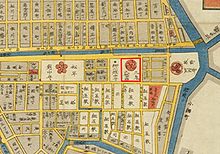Kuki (clan)
The Kuki ( Japanese 九 鬼 氏 , Kuki-shi ) were a family of the Japanese sword nobility ( Buke ), which came from the Shima province and which was derived from Fujiwara no Tadahira (880-949). With an income of 36,000 Koku , the Kuki residing in Sanda ( Osaka Prefecture ) belonged to the smaller Tozama daimyo of the Edo period .
genealogy
Main branch
- Yoshitaka ( 嘉隆 ; 1542–1600) ruled the Shima province, where he had built a castle in today's Toba . He submitted to Oda Nobunaga and served him in the campaigns against the Ikkō-ikki of Nagashima (now Kuwana ) etc. Toyotomi Hideyoshi put him in 1592 as the commander of the fleet for his Korean campaign . In 1600 he sided with Ishida Kazushige against Tokugawa Ieyasu in the Battle of Sekigahara and killed himself after the defeat.
- Moritaka ( 守 隆 ; 1573-1632), Yoshitaka's son, had taken over the Shima province in 1599 and served under Ieyasu. He was confirmed in his possession and his income increased from 26,000 to 46,000 koku. After his death, his sons shared the property.
- Hisataka ( 久隆 ; 1617–1649), a son of Moritaka, took over Toba and then from 1634 to 1868 Sanda ( Settsu ), where he resided in a permanent house ( jinya ). After 1868 Vice Count.
Secondary branch
- Takasue ( 隆 季 ; 1608–1678), another son of Moritaka, resided from 1633 to 1868 in a permanent house in Ayabe ( Tamba ) with 20,000 koku.
Individual evidence
- ↑ Furusawa, Tsunetoshi: Kamon daichō . Kin'ensha, undated, ISBN 4-321-31720-7 , pp.
- ↑ a b Excerpt from the district maps "Soto-Sakurada" and "Nihonbashi-minami" from approx. 1850.
literature
- Edmond Papinot: Historical and Geographical Dictionary of Japan. Reprint of the 1910 edition. Tuttle, 1972, ISBN 0-8048-0996-8 .
- Miura, Masayuki (Ed.): Shiro to jinya. Saikoku-hen. Gakken, 2006. ISBN 978-4-05-604379-2 .
- Miyaji, Saichiro (Ed.): Bakumatsu shoshu saigo-no hanshu-tachi. Nishinihon-hen. Jinbunsha, 1997. ISBN 978-4-7959-1906-8 .



